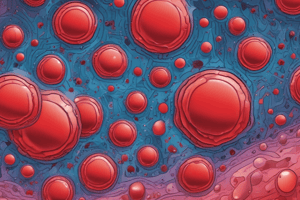Podcast
Questions and Answers
What is the primary function of erythropoietin?
What is the primary function of erythropoietin?
- To stimulate RBC production (correct)
- To stimulate platelet production
- To stimulate clotting
- To stimulate WBC production
The majority of blood cells are platelets.
The majority of blood cells are platelets.
False (B)
What are the three precursors of blood cell types?
What are the three precursors of blood cell types?
Granulocytes, Erythrocytes, and Thrombocytes
The bone marrow maintains a reserve supply of RBCs, which last approximately ______ days.
The bone marrow maintains a reserve supply of RBCs, which last approximately ______ days.
Match the following blood cell types with their characteristics:
Match the following blood cell types with their characteristics:
What is the name of the hormone that stimulates the production of circulating blood cells by the bone marrow?
What is the name of the hormone that stimulates the production of circulating blood cells by the bone marrow?
What are the three essential nutrients required for erythropoiesis?
What are the three essential nutrients required for erythropoiesis?
The majority of blood volume is composed of cells.
The majority of blood volume is composed of cells.
What is the normal range of Hemoglobin (HgB) for a woman?
What is the normal range of Hemoglobin (HgB) for a woman?
According to the European Blood Committee (EBC), transfusions should be given to people with HgB less than 10.
According to the European Blood Committee (EBC), transfusions should be given to people with HgB less than 10.
What is the function of heme in Hemoglobin?
What is the function of heme in Hemoglobin?
The breakdown of heme portion of blood produces _______________________.
The breakdown of heme portion of blood produces _______________________.
Match the following vitamins with their functions in Hemoglobin formation:
Match the following vitamins with their functions in Hemoglobin formation:
What is the name of the protein that transports iron in the body?
What is the name of the protein that transports iron in the body?
Whole milk is a rich source of iron.
Whole milk is a rich source of iron.
What happens when there is a lack of Vitamin B12 in the body?
What happens when there is a lack of Vitamin B12 in the body?
Flashcards are hidden until you start studying
Study Notes
Hematology (RBCs)
- Blood performs three main functions: transportation, regulation, and protection
- Transportation: nutrients, oxygen, RBCs, waste products, and hormones
- Regulation: acid-base balance, fluid balance (albumin), and heat regulation
- Protection: antibodies, phagocytes, and clotting
Blood Composition
- Blood volume consists of plasma and cells
- Plasma: clear yellow fluid containing albumin, globulins, and fibrinogen, important for fluid volume, coagulation, and binding (Fe2+)
- Cells: 99% RBCs, 1% WBCs and platelets
- 1 unit of blood = 450mL (7% of body volume)
- Women: 5.3L blood volume
- Men: 7.6L blood volume
Hematopoiesis
- Formation of blood cells in bone marrow
- Stem cells develop into three precursors of blood cell types: granulocytes, erythrocytes, and thrombocytes
- Stem cells can be committed or uncommitted
- Uncommitted: develop into any kind of cell
- Committed: become a Colony Forming Unit to a specific cell line
- Colony Stimulating Factor (CSF): naturally occurring hormone controlling blood cell production
- Can be given artificially to increase production (e.g., Neupogen, Epogen)
Erythropoiesis
- Formation of RBCs requires "FIB": folate, iron, and B12
- Stimulated by hypoxia, low RBC count, and erythropoietin
- Characteristics of RBCs:
- 4-6 million per microliter
- No nucleus
- Biconcave shape for flexibility and increased surface area for oxygen
- Immature RBC: reticulocyte (lives 1 day)
- Normal HgB levels: men 14-18, women 12-16
Hemoglobin (HbG)
- Heme: iron-containing portion of HbG, binds and contains four O2 molecules
- Breakdown of heme portion produces bilirubin
- Bilirubin not broken down is deposited into tissue, causing yellow color
- Excreted in the small intestine to be broken down
- Globin: two proteins bound by iron
Elements for HbG Formation
- Iron:
- Mineral essential for heme synthesis
- Stored in liver as ferritin, reused to produce new RBCs
- Transported by transferrin
- Absorbed better with vitamin C
- Vitamin B12 (Cobalamin):
- Stored in liver until needed
- Important for RBC DNA synthesis
- Lack of B12 inhibits DNA synthesis, leading to megaloblastic anemia
Studying That Suits You
Use AI to generate personalized quizzes and flashcards to suit your learning preferences.




